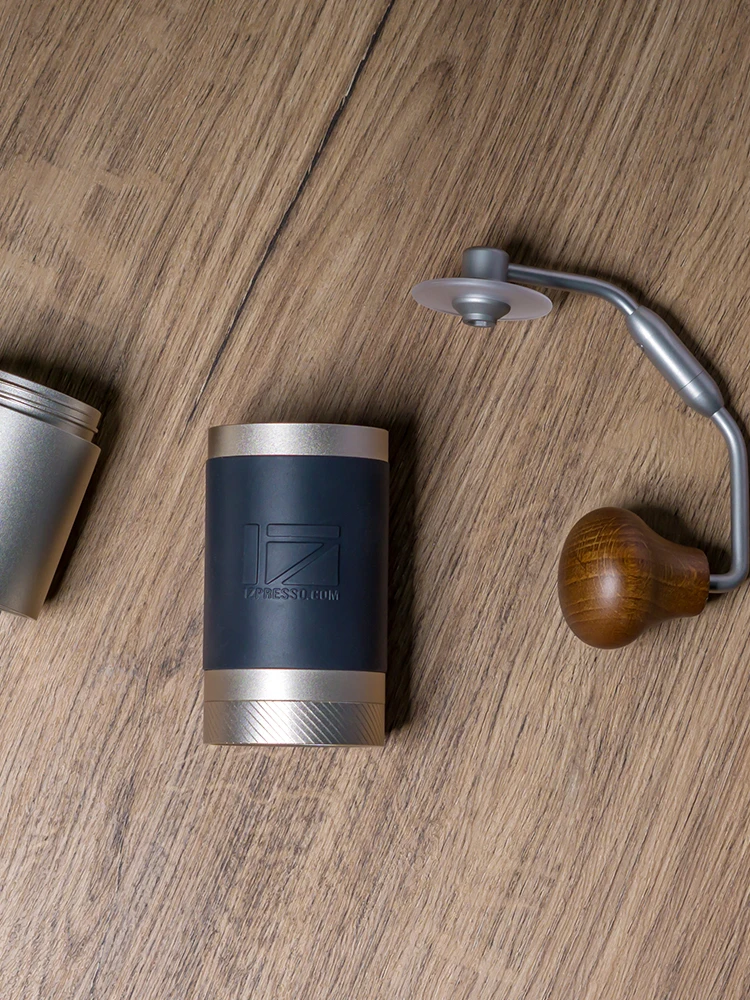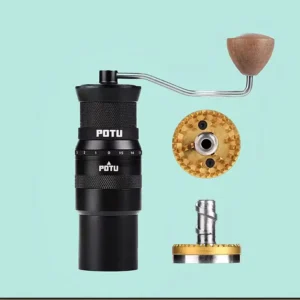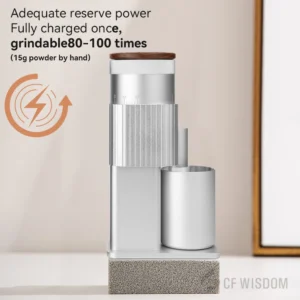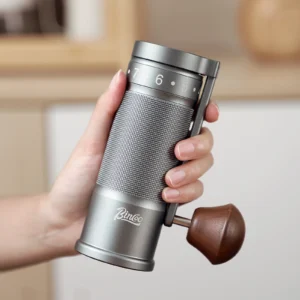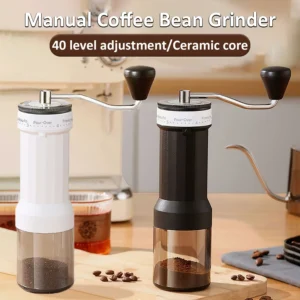Understanding Why Grind Size is Critical for Espresso Success
Making great espresso is like solving a puzzle, and the grind size is the most important piece. When you adjust how fine or coarse your coffee beans are ground, you directly impact how water flows through the coffee under pressure. Think of it as water trying to move through sand versus pebbles – the finer the particles, the slower the water moves.
Getting your grind size right matters because:
- It controls how quickly water passes through your coffee puck
- It determines how much flavor is extracted from the beans
- It’s the main factor in achieving balanced taste
- It affects the quality and appearance of your crema
When espresso extraction happens, different compounds dissolve at different stages – first the bright acids, then the sweet notes, and finally the bitter compounds. A proper grind setting ensures you get the perfect balance of these flavors instead of an unpleasant sour or bitter shot.
The beauty (and challenge) of espresso making lies in how immediately you can see and taste the impact of your grind adjustments. The same coffee beans and machine can produce completely different results with just a small tweak to your grinder settings. This is why mastering espresso precision grind settings is essential for anyone serious about their home espresso.
Recognizing the Ideal Espresso Grind: Visual and Tactile Characteristics
When you’re aiming for the perfect espresso grind, knowing what to look for makes all the difference. An ideal espresso grind has distinct characteristics you can identify with your eyes and fingers:
Visual appearance:
– Finer than table salt but coarser than flour
– Uniform particle size (ideally between 200-400 microns)
– Slightly clumpy but breaks apart easily
– Powdery appearance but not dusty
Tactile feel:
– Should feel like fine powder with slight grittiness when rubbed between fingers
– Slightly cohesive (will form loose clumps when pressed)
– Not so fine that it feels like talcum powder
– Not so coarse that you can feel individual particles easily
A helpful comparison: good espresso grind resembles powdered sugar in texture – fine and somewhat fluffy, but with a bit more grit. If you’re comparing across common household substances, it’s finer than granulated sugar but not as fine as cornstarch.
The consistency of your grind matters just as much as the size. Uneven particle distribution leads to uneven extraction, with some particles over-extracting while others under-extract. This is why quality precision manual grinders designed specifically for espresso can make such a difference – they produce more uniform particle sizes than cheaper blade grinders.
For those who want to dive deeper into the visual aspects of proper grinding, our ultimate espresso grind size chart provides detailed visual references for comparison.
The Science Behind Grind Size and Extraction Pressure
Understanding the relationship between grind size and extraction pressure helps explain why getting your grind right is so crucial. In essence, it’s all about resistance and flow.
When water is forced through coffee grounds under pressure (typically 9 bars or about 130 psi in espresso machines), the size of the coffee particles determines how much resistance the water encounters. This resistance directly affects both extraction time and flavor development.
Finer grounds create:
– Higher resistance to water flow
– Increased surface area exposed to water
– Longer contact time between water and coffee
– Higher extraction percentage (more compounds pulled from the coffee)
Think of your coffee puck as a filter with thousands of tiny pathways. The finer you grind, the narrower these pathways become. When pathways are too narrow (grind too fine), water struggles to pass through evenly and may find “channels” of least resistance. When pathways are too wide (grind too coarse), water rushes through too quickly without extracting enough flavor.
The definitive guide to espresso grind texture explores how different particle shapes and sizes influence extraction. Finding the perfect balance is what allows your machine to maintain optimal pressure throughout extraction, resulting in that sweet spot of flavor development.
Recognizing Signs of Incorrect Grind Size
Learning to identify when your grind size is off will save you time and frustration. Here’s how to tell if your espresso grind needs adjustment:
| Issue | Too Coarse (Under-extracted) | Too Fine (Over-extracted) |
|---|---|---|
| Flow Rate | Fast (under 15-20 seconds) | Very slow (over 35-40 seconds) or choking |
| Crema | Pale, thin, quickly disappears | Dark, spotty, sometimes with “tiger striping” |
| Taste | Sour, sharp, acidic, watery | Bitter, harsh, astringent, hollow |
| Appearance | Light color, transparent | Very dark, sometimes muddy |
| Shot Volume | Often exceeds target yield quickly | Struggles to reach target yield |
When your grind is too coarse, the espresso flows too quickly because water easily passes between the larger coffee particles. This results in under-extraction – where not enough of the desirable flavors are dissolved from the coffee. The shot might look pale and watery, taste sour or sharp, and the crema will be thin or barely present.
Conversely, when your grind is too fine, the espresso flows very slowly or might not flow at all (choking). The excessive resistance means water stays in contact with the coffee too long, resulting in over-extraction – where too many bitter compounds are pulled from the coffee. The shot appears very dark, tastes bitter or harsh, and might have dark, spotty crema.
Using a manual coffee grinder designed for espresso can give you the fine control needed to avoid these issues, as they typically offer more precise adjustment capabilities than general-purpose grinders.
Essential Tools for Precision Espresso Dialing-In
To consistently achieve the perfect espresso grind, having the right tools makes all the difference. Here are the essential items that will help you dial in your shots with precision:
Quality burr grinder: The foundation of good espresso. Look for grinders with fine adjustment capabilities and consistent particle size distribution.
Precision scale (0.1g accuracy): Eliminates guesswork by ensuring your coffee dose is exactly the same each time, allowing you to isolate grind size as a variable.
Shot timer: Helps you measure extraction time accurately, whether standalone or built into your machine.
Distribution tool: Ensures even coffee distribution in the portafilter, preventing channeling that can ruin shots regardless of grind quality.
Consistent tamper: Provides even pressure when compacting your coffee grounds, reducing another variable in your process.
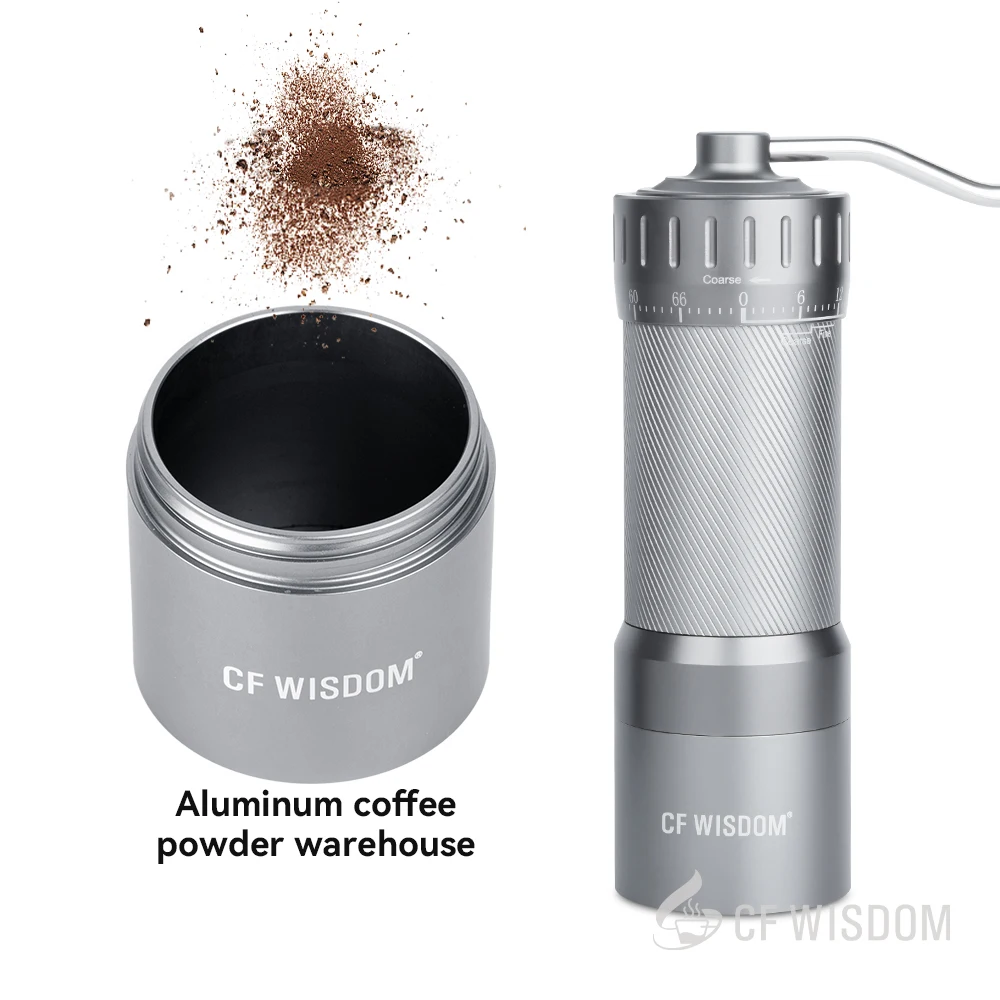
While you can make acceptable espresso without all these tools, each one removes a variable from the equation, making it easier to identify when grind size specifically needs adjustment. For example, without a scale, you might attribute problems to grind size when they’re actually caused by inconsistent dosing.
The right fine adjustment hand grinder can make a significant difference in your results. These specialized tools offer micro-adjustments that let you fine-tune your grind with precision, often allowing for subtle changes that can transform a good shot into a great one.
Establishing Your Baseline Espresso Recipe
Before adjusting your grind size, you need a consistent baseline recipe to work from. This gives you a control point for making and measuring changes. A standard espresso recipe includes three main components:
- Dose: The amount of ground coffee you use (input)
- Yield: The amount of espresso produced (output)
- Time: How long the extraction takes
For a standard double espresso, start with:
– Dose: 18 grams (0.63 oz) of coffee
– Yield: 36 grams (1.27 oz) of espresso (a 1:2 ratio)
– Time: 25-30 seconds from when you start the pump to when you stop the shot
This 1:2 brew ratio (coffee to espresso) is a widely accepted starting point that works well with most beans and machines. It provides a balanced extraction that’s neither too concentrated (like a ristretto) nor too diluted (like a lungo).
To establish your baseline:
– Weigh your dose precisely each time
– Distribute grounds evenly in the portafilter
– Apply consistent tamping pressure
– Time your shot from the moment you start the pump
– Weigh your final shot to confirm the yield
Remember that correct grind setting for espresso depends on maintaining consistency in all other variables. Only then can you accurately assess whether your grind size needs adjustment. Once you’ve established this baseline, you’re ready to begin the dialing-in process.
The Step-by-Step Dialing-In Process for Perfect Extraction
Now that you understand the theory and have established a baseline recipe, here’s a methodical approach to finding your perfect grind setting:
Start with your baseline grinder setting (if you don’t have one, begin with a fine setting that looks like powdered sugar)
Prepare your shot meticulously:
– Weigh 18g (0.63 oz) of coffee beans
– Grind them at your current setting
– Distribute evenly in the portafilter
– Tamp with consistent pressure
– Lock the portafilter into your machinePull your shot and observe:
– Start your timer when you start the pump
– Watch the flow development
– Stop the shot when you reach 36g (1.27 oz) yield
– Note the total extraction timeAssess the results:
– If extraction time is under 20 seconds: Your grind is too coarse
– If extraction time is over 35 seconds: Your grind is too fine
– If extraction time is 25-30 seconds: You’re in the target rangeMake precise adjustments:
– For too fast shots: Adjust grinder 1-2 notches finer
– For too slow shots: Adjust grinder 1-2 notches coarser
– For minor tweaks: Make smaller, half-notch adjustmentsPurge your grinder after each adjustment by grinding and discarding 3-5g (0.1-0.18 oz) of beans to clear any old grounds
Repeat the process until you achieve:
– The target extraction time (25-30 seconds)
– A steady flow that resembles warm honey
– A shot that begins with dark drops and develops into a consistent stream
This iterative process is the heart of mastering perfect espresso grind adjustments. Be patient – finding the perfect setting may take several attempts, especially with new beans or equipment. Make only one adjustment at a time and keep notes of your results to track your progress.
Developing Your Palate: Tasting to Fine-Tune Your Grind
While timing and visual cues are helpful guides, taste is ultimately the most important measure of your espresso’s quality. Learning to taste espresso analytically will help you make micro-adjustments to your grind setting for perfect extraction.
To taste espresso properly:
– Take small sips that cover your entire tongue
– Note where and how you experience different flavors
– Pay attention to the aftertaste and how it develops
– Wait a minute and take a second sip to detect subtler notes
Key flavor indicators to watch for:
Front of tongue sensations: Sharp acidity or sourness typically indicates under-extraction from a grind that’s too coarse. The shot runs too quickly, not extracting enough of the balancing sweet compounds.
Mid-palate sweetness: A pleasant sweetness in the middle of your tongue suggests optimal extraction. This is your target – a balanced shot where the grind setting is just right.
Back of tongue sensations: Intense bitterness or drying astringency points to over-extraction from a grind that’s too fine. The water has pulled too many bitter compounds from the coffee.
The goal is balance – some acidity, good sweetness, and just enough bitterness to provide complexity. If you notice both sourness and bitterness simultaneously, this often indicates channeling, where water finds paths of least resistance through the coffee puck.
For a deeper understanding of how grind size specifically impacts flavor development, our definitive guide to espresso grind size and flavor provides detailed tasting notes for different extraction levels.
Key Factors That Influence Your Ideal Grind Setting
Understanding that grind setting isn’t a “set it and forget it” parameter is crucial for espresso success. Multiple factors influence your ideal grind setting, requiring regular adjustments:
Bean Variables:
– Roast level: Lighter roasts generally require finer grinds than darker roasts because they’re harder and denser
– Bean age: Fresh beans (3-14 days off roast) often need coarser settings as they contain more CO2 that can cause resistance
– Origin: Different growing regions produce beans with varying density requiring different grinds
– Processing method: Natural processed coffees might require slightly different settings than washed coffees
Equipment Factors:
– Grinder type: Flat burrs versus conical burrs distribute particles differently
– Burr condition: Worn burrs produce more inconsistent particles requiring compensation
– Machine pressure: Higher pressure machines may need slightly coarser grinds
– Basket design: Precision baskets with more holes may require finer grinding
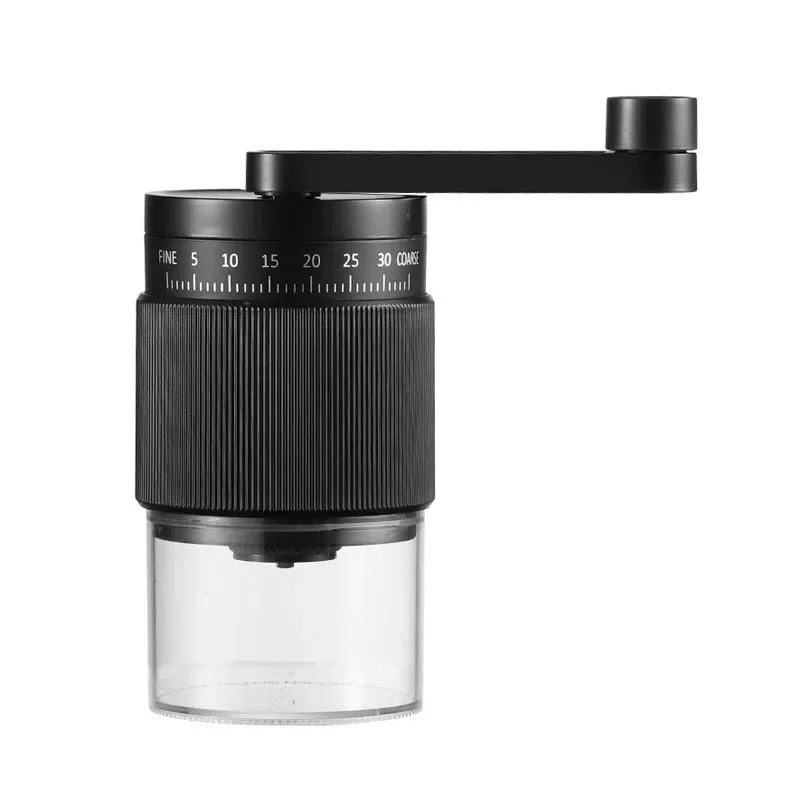
Environmental Conditions:
– Humidity: Higher humidity can make grounds absorb moisture and extract differently
– Temperature: Ambient temperature affects both bean grinding and extraction
– Altitude: Higher altitudes may require grind adjustments due to different boiling points
Don’t be surprised if your perfect setting from yesterday needs adjustment today – this is normal! Coffee is a natural product that responds to its environment. Having a quality manual espresso grinder with precise adjustment capabilities allows you to make these necessary fine-tuning adjustments consistently.
Solving Common Grind-Related Espresso Problems
Even experienced baristas encounter extraction issues. Here’s how to diagnose and fix common problems related to grind settings:
| Problem | Likely Causes | Solutions |
|---|---|---|
| Channeling/Spraying | Too fine grind or uneven distribution | Coarsen grind slightly, improve distribution technique |
| No flow/”Choking” | Extremely fine grind | Significantly coarsen grind, check for clumping |
| Inconsistent shots | Grinder retention, temperature fluctuations | Purge between shots, allow machine to stabilize |
| Fast flow + bitter taste | Potential coffee fines issue | Check grinder burr alignment, try different distribution |
| Simultaneous sourness and bitterness | Channeling | Improve puck preparation, consider WDT technique |
Troubleshooting Specific Issues:
Spurting/spraying: If your espresso sprays in multiple directions from the portafilter, you likely have channeling. This happens when water finds easier paths through the coffee puck. Try a slightly coarser grind and ensure even distribution before tamping.
Blonding too early: When your espresso stream turns from dark to pale yellow too quickly, your grind is likely too coarse. The water is passing through too quickly, leaving desirable compounds behind.
Dead spots: Areas of the portafilter where no espresso emerges often indicate uneven distribution rather than a grind problem. However, very fine grinds can exacerbate this issue.
Delayed start: If it takes more than 5-7 seconds for the first drops to appear, your grind is probably too fine, creating too much resistance.
For more detailed guidance on achieving perfect shots through proper grind settings, our espresso grind settings guide provides comprehensive troubleshooting advice.
Grinder Maintenance for Consistent Results
A well-maintained grinder is essential for consistent espresso quality. Even the perfect grind setting will produce poor results if your grinder isn’t properly cleaned and maintained. Follow this maintenance schedule to ensure optimal performance:
Daily maintenance:
– Brush away loose grounds from burrs and grinding chamber
– Wipe down the exterior and bean hopper
– Run a few beans through after adjusting to eliminate retained grounds
Weekly maintenance:
– More thorough brush cleaning of burr chambers
– Check for buildup in the grinding path
– Clean the grounds bin thoroughly
Monthly maintenance:
– Remove and clean burrs according to manufacturer instructions
– Remove oil buildup with a grinder cleaning product
– Check for signs of burr wear
Signs your grinder needs attention:
– Inconsistent grind sizes appearing in your grounds
– Strange noises during grinding
– Metallic taste in your coffee
– Difficulty achieving consistent extraction times
– Visible burr damage
After any deep cleaning that involves disassembling parts, you’ll likely need to recalibrate your grinder and find your ideal setting again. Keep notes on your preferred settings to make this process easier.
Quality hand burr grinders often require less frequent deep cleaning than electric models because they generate less heat and static, which contribute to coffee oil buildup. However, regular maintenance is still essential for consistent results.
Advanced Techniques: Beyond Basic Dialing-In
Once you’ve mastered the fundamentals of grind adjustment, these advanced techniques can help you achieve even better espresso:
WDT (Weiss Distribution Technique): Using a fine tool (like a dissected paperclip or specialized WDT tool) to gently stir the grounds in the portafilter breaks up clumps and ensures even distribution. This becomes increasingly important as you grind finer, as finer particles tend to clump more.
RDT (Ross Droplet Technique): Adding a tiny drop of water to your beans before grinding reduces static and improves distribution consistency. Simply dampen a spoon handle, stir the beans briefly, then grind.
Single dosing: Grinding only the exact amount of beans needed for each shot minimizes coffee waste and ensures maximum freshness. This approach pairs perfectly with precision grind adjustment for espresso because it eliminates variables from bean degradation in hoppers.

Puck preparation: As you refine your grind setting, puck preparation becomes increasingly important. Consider:
– Even distribution tools or techniques
– Consistent tamping pressure
– Proper portafilter angle during tamping
– Pre-infusion to minimize channeling
Temperature surfing: Learning to pull shots at consistent temperatures by timing your shot in relation to your machine’s heating cycle. Different temperatures may require slight grind adjustments.
Fine Adjustment Hand Grinder, Precision Manual Grinder, Travel Coffee Grinder
Price range: $185.11 through $494.63 Select options This product has multiple variants. The options may be chosen on the product pageHand Burr Grinder, Hand Crank Coffee Grinder, Manual Espresso Grinder, Portable Coffee Grinder
Price range: $262.72 through $300.22 Select options This product has multiple variants. The options may be chosen on the product pageHand Burr Grinder, Manual Coffee Grinder Stainless Steel, Precision Manual Grinder
Price range: $183.64 through $187.52 Select options This product has multiple variants. The options may be chosen on the product pageCeramic Burr Coffee Grinder, Hand Burr Grinder, Hand Crank Coffee Grinder, Manual Coffee Bean Grinder
Price range: $59.17 through $59.96 Select options This product has multiple variants. The options may be chosen on the product page
Remember that these advanced techniques work together with proper grind settings – neither can compensate completely for deficiencies in the other. Focus first on getting your grind right, then refine these additional variables.
Different Grinders, Different Approaches: Equipment Considerations
Not all grinders are created equal, and understanding your specific equipment is essential for optimal results:
Grinder Types and Capabilities:
Entry-level electric burr grinders: Often have fewer adjustment steps and may struggle with ultra-fine espresso grinds. You might need to use other variables (dose, tamp pressure) to compensate for limited grind adjustment range.
Manual precision grinders: Quality hand grinders often provide excellent grind consistency and very fine adjustment capability, though they require more effort. Their stepless or micro-stepped adjustment mechanisms allow for tiny incremental changes ideal for dialing in espresso.
Prosumer electric grinders: Provide more adjustment steps or stepless design, allowing for precise calibration. These often have better burr quality and alignment, producing more consistent particle sizes.
Commercial grinders: Offer exceptional consistency but are often designed for high-volume use rather than single dosing.
When using burr grinders for espresso preparation, remember that different models use different nomenclature for their settings. A “setting 8” on one grinder might produce a completely different grind size than “setting 8” on another. Focus on the results rather than the numbers.
If switching between grinders, expect to start your dialing-in process from scratch, as there’s rarely a direct conversion between different models’ adjustment scales.
Adapting Your Grind for Different Espresso Styles
Different espresso styles require adapting your grind setting to achieve optimal results:
Ristretto (1:1 ratio): This concentrated style pulls less water through the coffee, resulting in about 18g (0.63 oz) out from 18g (0.63 oz) in. For ristretto, you typically need a slightly finer grind than regular espresso to extend the extraction time despite the lower water volume.
Regular espresso (1:2 ratio): The standard approach we’ve focused on throughout this guide, with approximately 36g (1.27 oz) of espresso from 18g (0.63 oz) of coffee in about 25-30 seconds.
Lungo (1:3+ ratio): This longer style produces more volume (54g/1.9 oz or more from 18g/0.63 oz coffee). To achieve proper extraction without excessive bitterness, a slightly coarser grind is typically needed.
Specialty light roasts: Modern specialty coffees, especially lighter roasts, often benefit from:
– Slightly finer grinds to increase extraction
– Lower water temperatures to prevent harsh acidity
– Longer pre-infusion to help water penetrate the dense beans
Traditional Italian style: Classic dark-roasted Italian espresso typically works best with:
– Slightly coarser grinds
– Higher brewing temperatures
– Shorter overall extraction times
Having versatile espresso coffee hand grinders allows you to easily switch between different grind profiles for these various styles, especially if you enjoy experimenting with different espresso approaches.
Embracing the Journey: Mindset for Espresso Excellence
Mastering espresso grind settings isn’t a destination but a continuous journey. The most successful home baristas approach this process with:
Curiosity and experimentation: Be willing to try different approaches and learn from both successes and failures. Each coffee variety presents new learning opportunities.
Systematic methodology: Change one variable at a time and take notes on the results. An espresso journal tracking beans, grind settings, extraction times, and taste notes can accelerate your learning.
Patience: Accept that you’ll waste some coffee in the learning process, and that’s okay. Every shot pulls you closer to consistency.
Attention to detail: Small changes make big differences in espresso. Train yourself to notice subtle variations in flow rate, crema development, and flavor.
Taste development: Your palate will evolve as you gain experience. What initially tastes acceptable will become clearly flawed as your sensitivity improves.
Remember that even professional baristas continuously refine their approach. The pursuit of the perfect shot is ongoing, with each adjustment teaching you more about the complex relationship between grind size and extraction quality.
FAQ: Common Questions About Espresso Grind Settings
Can I use the same grind setting for different beans?
No, each coffee variety typically requires unique adjustment. Different beans have varying densities, moisture levels, and roast degrees that all affect how water flows through them.
Do I need to adjust my grind as beans age?
Yes. Fresh beans (especially 3-10 days after roasting) contain more CO2 gas, which can create resistance during extraction. You’ll likely need to grind slightly coarser for very fresh beans and gradually adjust finer as they age.
How often should I adjust my grinder during daily use?
Environmental changes throughout the day (temperature, humidity) can affect your coffee’s extraction. Professional baristas often make small adjustments several times daily, especially in environments with fluctuating conditions.
Is it normal to waste coffee when dialing in?
Yes, some waste is unavoidable when finding the perfect setting. However, you can minimize waste by making smaller adjustments and saving slightly off shots for coffee milk drinks.
Do temperature changes require grind adjustments?
Yes, higher brewing temperatures generally extract more readily and might require a slightly coarser grind to compensate. Lower temperatures might need finer grinding to achieve proper extraction.
How can I tell if extraction problems are from my grind or something else?
Maintain strict consistency in all other variables (dose weight, distribution technique, tamping pressure) when troubleshooting. If changing only the grind resolves the issue, that confirms the grind was the problem.
Beyond Espresso: How Grind Settings Change for Other Brewing Methods
Understanding how espresso grind compares to other brewing methods provides helpful context for your coffee journey:
| Brewing Method | Relative Grind Size | Comparison Point |
|---|---|---|
| Turkish | Ultra-Fine | Finer than espresso, like powder |
| Espresso | Fine | Like powdered sugar or fine salt |
| Moka Pot | Medium-Fine | Between espresso and drip, like fine sand |
| Pour Over | Medium | Like regular sand or granulated sugar |
| French Press | Coarse | Like sea salt or breadcrumbs |
The fundamental principle remains the same across all methods: grind size controls extraction by determining surface area and flow rate. Methods with shorter contact times between water and coffee (like espresso) require finer grinds to increase surface area and extraction speed. Methods with longer contact times (like French press) need coarser grinds to prevent over-extraction.
This perspective helps you understand why espresso grinding is so demanding – it requires the most precision because the extraction happens so quickly under pressure. A small adjustment that might go unnoticed in a French press could make the difference between a perfect shot and an undrinkable one in espresso.
By mastering the precise grinding requirements for espresso, you’ll develop skills that transfer to all other brewing methods, making you a more versatile and skilled coffee enthusiast overall.

